Trends in Federal Funding Compliance
This article is an update of an article previously published on August 27, 2019
A common misconception is that federal grants compliance is the responsibility of the accounting department. However, the compliance requirements listed in Title 2 U.S. Code of Federal Regulations (CFR) Part 200, Uniform Administrative Requirements, Cost Principles, and Audit Requirements for Federal Awards (Uniform Guidance) – a government-wide framework for grant management, require the collaboration of the program delivery, operations support, and finance teams. It contains administrative requirements, cost principles, and audit requirements for federal awards. It defines minimum compliance requirements for organizations receiving federal funding.
Interestingly enough, the finance team is solely responsible for only two of the thirteen elements of compliance, cash management and program income. The remaining 11 elements either hold shared responsibility or are the responsibility of the program and operations teams. The table below shows each compliance element contained in the Uniform Guidance, the average rates of compliance, as well as which division is primarily responsible for complying with that element.
| Responsible Division
|
|||
|---|---|---|---|
| Average Rate of Compliance 2018-2020
|
Compliance Element
|
Finance
|
Program/Operations
|
96% |
Activities allowed/unallowed | ||
88% |
Unallowable costs/cost principles | ||
92% |
Cash management | ||
85% |
Eligibility | ||
97% |
Equipment and real property management | ||
97% |
Matching, level of effort, earmarking | ||
98% |
Period of performance | ||
86% |
Procurement, suspension and debarrment | ||
98% |
Program income | ||
78% |
Reporting | ||
96% |
Subrecipient monitoring | ||
73% |
Special tests and provisions | ||
81% |
Other | ||
In the eight years since Uniform Guidance was established, organizations that receive federal funding have worked to institute or update internal policies to ensure they are in compliance. The costs involved in meeting the compliance requirements have been substantial, but the costs of noncompliance can be staggering. Not only is there a cost associated with unraveling and documenting transactions and activities after the fact, but the cost of undocumented funds and activities may have to be refunded to the federal funding agency.
Our experience with the costs of noncompliance is purely anecdotal. But with our experience, we can take what is happening at a macro level and apply our understanding of what we see in our day to day work with non-profit organizations. This article is an update to an article we published in 2019, and examines data on federal grant funding and single audits occurring since that time. The data we examined includes organizations that end their fiscal year within the calendar year who are subject to single audits under Uniform Guidance (organizations receiving federal funds in excess of $750,000 per year).
Compliance by the numbers
Between CY 2013 and CY 2020, the number of organizations submitting single audits declined by 14.5%.
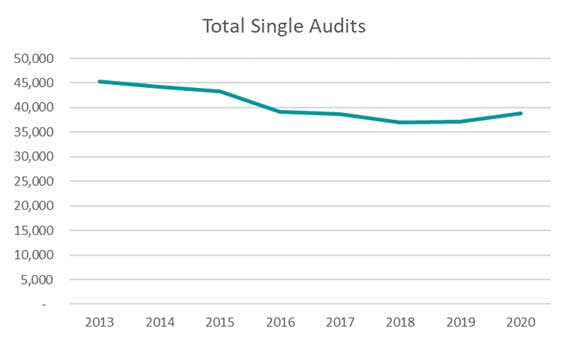
Nonprofit organizations comprised a little more than 50% of the total audits; however, they received less than 12% of the total funds that were audited. The types of organizations subject to single audit from 2018 to 2020 is broken down below:
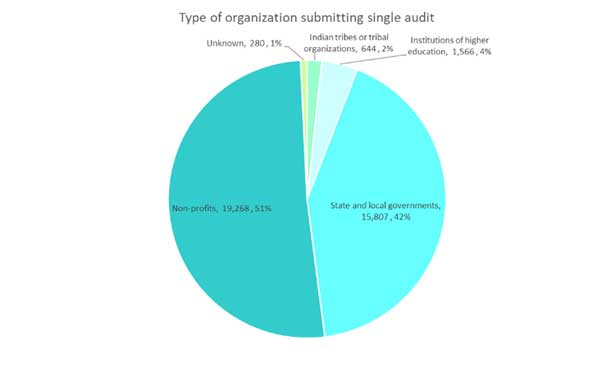
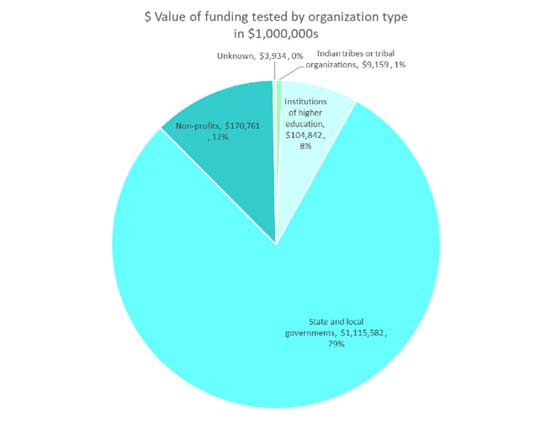
Overall compliance from CY 2013 declined during CY 2018 when a significant change in the procurement standard took effect. However, compliance improved the following two years. Interestingly enough, nonprofits led all other types of organizations in compliance, even though more nonprofits are subject to single audits than any other type of organization.
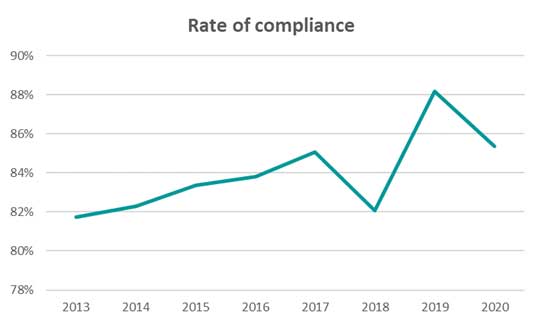
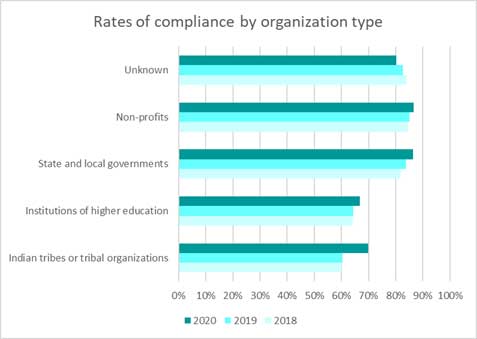
Federal grants compliance: Where are the problems?
While compliance has generally increased since 2018, issues persist. The table below shows noncompliant single audits from 2018-2020, and the type of finding as a percentage of total audits:
| Type
|
Title
|
2018
|
2019
|
2020
|
|---|---|---|---|---|
A |
Activities allowed/unallowed | 4% |
4% |
4% |
B |
Unallowable costs/cost principles | 12% |
13% |
11% |
C |
Cash management | 9% |
9% |
7% |
D |
Reserved | 0% |
0% |
0% |
E |
Eligibility | 15% |
15% |
14% |
F |
Equipment and real property management | 4% |
3% |
2% |
G |
Matching, level of effort, earmarking | 4% |
3% |
3% |
H |
Period of performance | 2% |
2% |
2% |
I |
Procurement, suspension and debarrment | 14% |
14% |
12% |
J |
Program income | 2% |
1% |
1% |
K |
Reserved | 0% |
0% |
0% |
L |
Reporting | 25% |
20% |
21% |
M |
Subrecipient monitoring | 5% |
4% |
4% |
N |
Special tests and provisions | 28% |
28% |
26% |
P |
Other | 19% |
18% |
18% |
Repeat Findings
For the findings listed above, there is an overall repeat finding incidence of 70%. The consequences of repeat findings can range from losing the right to direct deposit, the ability to receive advance funds, to increased scrutiny and reporting requirements from the funding agency, loss of future funding, and more costly and time-intensive single audits.
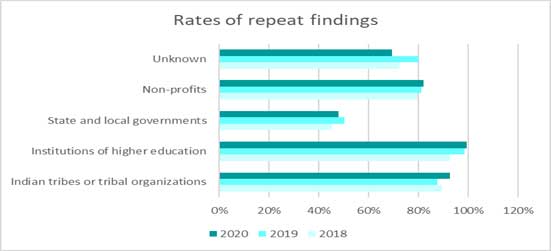
Repeat findings can be avoided if the organization creates and implements a corrective action plan that addresses the compliance findings. Not addressing the prior year’s compliance audit findings can result in undesirable implications. Repeat findings can build a negative reputation with funding partners, which could also jeopardize future funding opportunities.
Institutions of higher education suffer from the highest rate of repeat findings at 99%, compared to 82% for nonprofits. State and local governments have the lowest incidence of repeat findings, because their funding is often subject to reduction as a result of non-compliance. However, for institutions of higher education and non-profits, repeat findings rarely result in the loss of funding, but do result in increased scrutiny from funding agencies, damaged reputations with funding agencies, as well as more costly audits. It’s possible that organizations with repeat findings are less likely to address those findings in future years, concluding the consequences might simply be a part of the cost of doing business with the government.
Major areas of non-compliance
The sections below discuss the trends in major areas of non-compliance as shown in the table above.
Allowable Costs/Cost Principles: Identifies cost accounting requirements associated with federal awards. Compliance for unallowable costs and cost principles has continually improved; however, more than 10% of auditees still are still unable to conform.
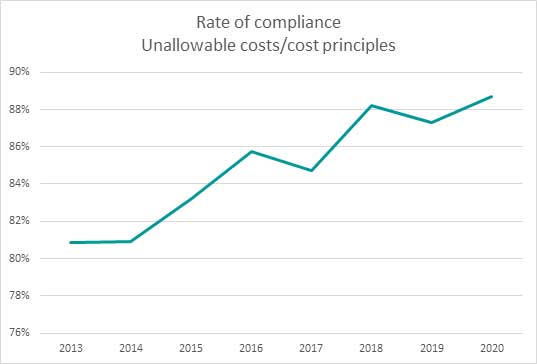
Findings in this area are generally related to costs that are improperly documented or incorrectly identified as allowable program costs. For example:
- Payroll allocations are based on an estimate rather than actual.
- Time related to program payroll is not contemporaneously documented.
- Time related to program payroll is not reviewed and properly approved.
- Program expenses are not reviewed and approved by grant manager.
- Indirect costs include unallowable costs.
- Indirect rate is misapplied.
Eligibility: Specifies the criteria for determining the individuals, groups of individuals, or sub-recipients that can participate in the program and the amount of assistance they qualify for. This relates to the eligibility of those who benefit from the program funded by the grant or contract rather than the eligibility of the funding recipient. Compliance in this area is trending up as organizations are better able to utilize technology and web-based applications to evaluate participate eligibility.
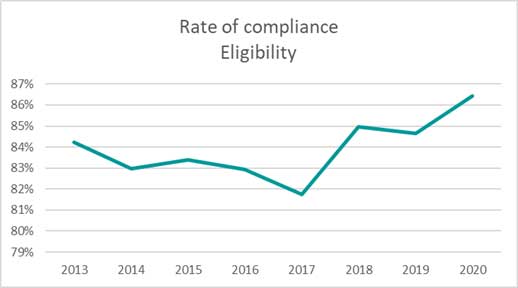
Findings are related to the documentation and process for identifying eligible participants, such as:
- Program participants did not meet the maximum age/income/geographic threshold.
- There is no process for identifying eligible participants.
- There is a process, but it is not executed consistently or documented appropriately.
Procurement, suspension, and debarment: Procurement: Non-federal organizations operating federal programs as sub-recipients of states must follow the Uniform Guidance procurement standards. Suspension and debarment: Non-federal entities are prohibited from contracting or making sub-awards with parties that are suspended or debarred. Compliance is generally down, but is trending back up from its low point in 2019.
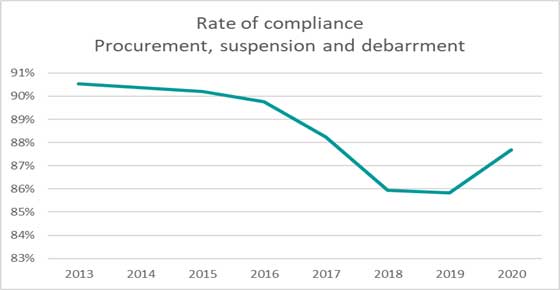
In 2018, the first year of implementation, the decline in compliance for procurement, suspension, and debarment was not a surprise. There were multiple revisions and delays in implementation and many conversations about this compliance requirement.
Findings in this compliance area relate to having written procurement policies, competition, and documentation of the process. For example:
- A procurement policy exists, but the organization does not enforce it.
- The organization has appropriate procedures but did not update its policy.
- The organization cannot prove that a vendor was checked for suspension and debarment.
We have seen some organizations establish policies that are more restrictive than necessary. For example, one entity subjected all procurement, not just covered transactions, to the procurement process as required under Uniform Guidance. As a result, the organization was out of compliance when it did not require a sealed bidding process for its information systems consulting or for its annual meeting space at a hotel. The organization clearly intended to exceed the expectations of its oversight agency but overshot its capacity to comply and ended up with procurement findings.
Reporting: Grant recipients are required to provide timely reporting based on each agency’s requirements. There may also be performance or special reports required. Compliance in this area is historically low. We believe that a possible reason recipients struggle with this compliance requirement is that each agency has a different reporting mechanism or system and varying reporting requirements.
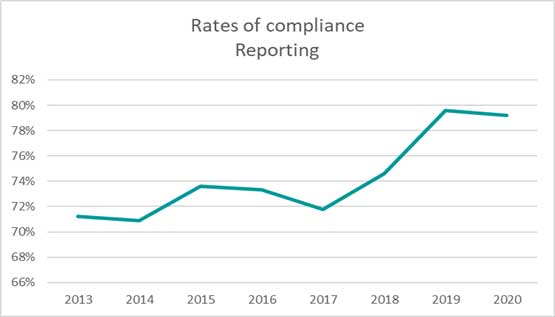
Findings in this compliance area relate to timely preparation, review, and submission of required financial and program reports. For example:
- Reports did not contain evidence of review or approval.
- Required reports were not filed timely.
Special tests and provisions: These are compliance requirements that are unique to each federal program. Unfortunately, recipients overlook the award document that provides these specific compliance requirements. These compliance findings result from agency or individual grant requirements, and are also historically low.
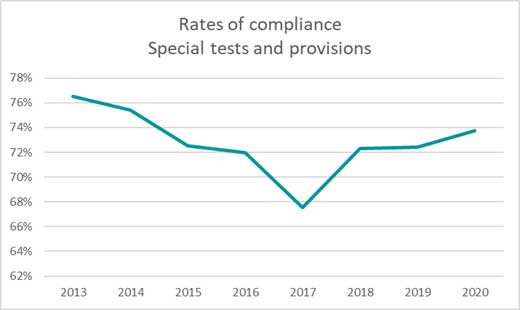
Findings in these compliance areas vary and depend on the program. Most happen because the recipient organization did not review the grant document for these requirements. For example:
- Lack of appropriate review and supervision for a mental health provider.
- Reserve accounts are not properly funded for a housing entity.
- Application of sliding fees charged for patients of a health clinic.
Other: These compliance findings are generally related to insufficient internal controls that might be specific to the performance of the grant or the failure to address prior audit findings with a corrective action plan.
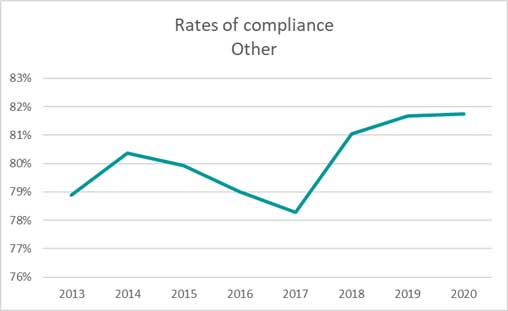
Findings in this compliance area vary and depend on the programs or agency providing funding. Examples of such findings are as follows:
- Internal controls are not sufficient to ensure compliance with grant requirements.
- Management failed to implement the corrective action plan (repeat findings).
- The corrective action plan did not remedy instances of noncompliance.
- Corrective action plan from prior year was not effective.
Conclusion
Some organizations have dropped the federal government as a funding source for either cost/benefit or political reasons. Those organizations that continue to receive federal funding can avoid most compliance findings with strong internal controls, proficient and skilled accounting staff, competent grant supervision and oversight, and continued federal grants accountability training for all divisions of organization staff. Organizations should also undergo a practical review of policies and procedures on an annual basis, to evaluate for efficiency, effectiveness and compliance.
Resources/Events
Please view our complimentary on-demand webinar, Federal Awards Compliance & You, for additional reminders on how to remain compliant with your federal awards and avoid some common pitfalls during federal audits.



















